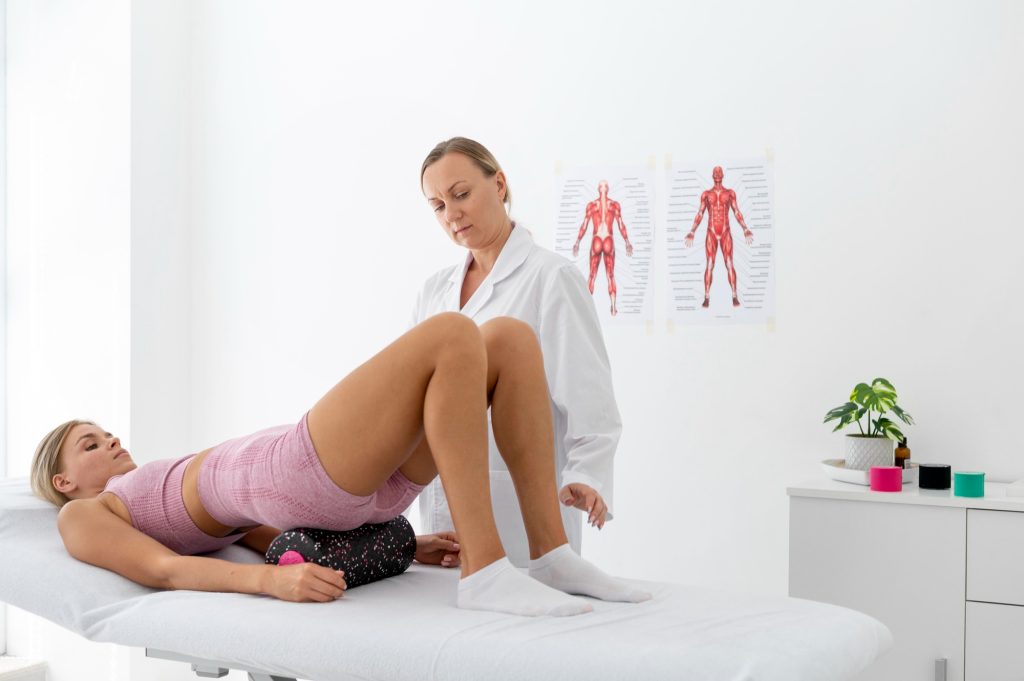Discover the connection between feeding frequency and duration and postpartum back pain.
How Does Feeding Frequency and Duration Impact Postpartum Back Pain?

As a new parent, you may find yourself facing aches and pains you never expected. One common discomfort that many moms experience is postpartum back pain. But did you know that the way you feed your baby can actually impact the severity of this pain? In this article, we’ll dive into the fascinating connection between feeding frequency, duration, and postpartum back pain. So, grab a cup of tea and let’s unravel this mystery together!
Understanding Postpartum Back Pain
Before we delve into the impact of feeding on back pain, let’s first understand what postpartum back pain is all about. After the magical journey of pregnancy and birthing, your body undergoes significant changes, and some of those changes can cause discomfort. Postpartum back pain happens when the muscles and ligaments in your back that supported your growing baby start to feel the strain of motherhood.
During pregnancy, your body produces a hormone called relaxin, which helps to loosen the ligaments in your pelvis to prepare for childbirth. After giving birth, the levels of relaxin in your body remain elevated for a while, which can cause the ligaments in your back to become more flexible and less stable. This increased flexibility, combined with the strain of carrying and caring for your newborn, can lead to postpartum back pain.
Another factor that contributes to postpartum back pain is the weight gain during pregnancy. As your baby grows, your body naturally adjusts to accommodate the extra weight. However, once your baby is born, your body needs time to readjust to its pre-pregnancy state. This readjustment can put additional stress on your back muscles, leading to discomfort and pain.
Causes of Postpartum Back Pain
There are several factors that contribute to postpartum back pain. One of the main culprits is the hormonal changes that occur during pregnancy and that continue after giving birth. These hormones loosen the joints and ligaments in your pelvis, which can put extra stress on your back. The weight gain during pregnancy and the new demands of lugging around your adorable little one can also strain your back muscles.
In addition to hormonal changes and weight gain, the physical demands of motherhood can also contribute to postpartum back pain. From breastfeeding and carrying your baby to bending over to change diapers and lifting car seats, these repetitive movements and positions can strain your back muscles and lead to discomfort.
Symptoms and Diagnosis of Postpartum Back Pain
So, how do you know if you’re experiencing postpartum back pain? Look out for dull or sharp pain in your lower back, stiffness or difficulty moving, and even radiating pain down your legs. These symptoms can vary in intensity and may worsen with certain activities or positions. It’s important to note that postpartum back pain can occur immediately after giving birth or develop gradually over time.
If you’re unsure whether your symptoms are related to postpartum back pain, it’s always best to consult with your healthcare provider. They can evaluate your symptoms, review your medical history, and perform a physical examination to determine the cause of your pain. In some cases, further diagnostic tests, such as X-rays or MRI scans, may be necessary to rule out other underlying conditions.
Remember, postpartum back pain is a common condition that many new mothers experience. It’s essential to take care of your physical and emotional well-being during this time. Seeking support from healthcare professionals, practicing good posture, engaging in gentle exercises, and utilizing pain management techniques can all help alleviate postpartum back pain and promote a healthy recovery.
The Role of Feeding Frequency in Postpartum Back Pain
Now let’s explore the impact of feeding frequency on postpartum back pain. As a new mom, you may find yourself spending a significant amount of time nursing your little bundle of joy. But did you know that this prolonged feeding can contribute to back pain? Let’s dig deeper!
The Physiology of Feeding and Back Pain
During feeding, your body goes through a range of physical motions. These motions, such as hunching over to position your baby or holding them in an uncomfortable position, can put strain on your back muscles. Additionally, all those late-night feeding sessions when you’re exhausted can lead to poor posture, further exacerbating the pain.
Let’s take a closer look at the physiology behind feeding and its impact on your back. When you hunch over to position your baby, your spine is forced into a flexed position, which can compress the intervertebral discs and strain the surrounding muscles. The prolonged periods of holding your baby in an uncomfortable position can also lead to muscle imbalances and tension in your back, contributing to the development of back pain.
Furthermore, the exhaustion that comes with being a new mom can have a significant impact on your posture during feeding. When you’re tired, it’s natural to slouch or slump, putting additional stress on your back. This poor posture not only increases the strain on your back muscles but also affects the alignment of your spine, potentially leading to long-term issues if not addressed.
Feeding Frequency and Its Impact on the Spine
When it comes to feeding frequency, finding a balance is key. While it’s important to meet your baby’s nutritional needs, frequent feeding sessions can put repetitive strain on your spine. The constant bending, twisting, and reaching can take a toll on your back muscles and ligaments, leading to discomfort over time.
It’s important to note that every mother and baby is unique, and there is no one-size-fits-all approach to feeding frequency. However, it’s generally recommended to establish a feeding routine that allows for adequate rest and recovery for your back. This may involve spacing out feeding sessions to give your back a break, utilizing different feeding positions to distribute the load on your muscles, and ensuring proper support for both you and your baby during feeding.
Additionally, incorporating gentle stretching and strengthening exercises into your daily routine can help alleviate back pain associated with feeding. Exercises that target the core and back muscles can improve posture, increase stability, and reduce the risk of developing muscle imbalances.
Remember, taking care of your own physical well-being is just as important as taking care of your baby. By being mindful of your feeding frequency and implementing strategies to support your back, you can minimize the risk of postpartum back pain and enjoy this precious time with your little one to the fullest.
The Impact of Feeding Duration on Postpartum Back Pain
Now that we’ve explored how feeding frequency can contribute to back pain, let’s turn our attention to feeding duration. While snuggling up with your little one for long feeding sessions may be cozy, it can also impact your back health. Let’s unravel this connection!
Long-Term Effects of Prolonged Feeding Sessions
Spending extended periods in the same position while breastfeeding or bottle-feeding can strain your back muscles and ligaments. The longer you remain in one position, the greater the risk of developing discomfort or pain. So, while those marathon snuggle sessions are bonding moments, it’s essential to take breaks and give your back a breather.
When you breastfeed for an extended period, your back muscles have to work harder to support your upper body and maintain a proper feeding position. This prolonged strain can lead to muscle fatigue and tension, increasing the likelihood of experiencing back pain. Additionally, the ligaments in your back can become overstretched, causing further discomfort.
It’s important to note that the impact of prolonged feeding sessions on back pain may vary from person to person. Factors such as individual strength, posture, and overall health can influence the severity of the discomfort experienced. However, it’s always a good idea to be mindful of your body’s signals and take necessary precautions to avoid unnecessary strain.
Short-Term Effects of Brief Feeding Sessions
On the other hand, short and rushed feeding sessions can also contribute to postpartum back pain. When you’re rushed, it’s easy to forget about your posture and end up slouched or sitting in an uncomfortable position. So, while efficiency is important, remember to find a balance between speed and maintaining good posture.
When you rush through feeding sessions, you may not give enough attention to your body’s alignment. Slouching or sitting in an awkward position can put unnecessary stress on your back, leading to muscle strain and discomfort. It’s crucial to prioritize your posture and ensure that you’re sitting in a supportive and comfortable position while feeding your baby.
Moreover, brief feeding sessions can also result in inadequate rest for your back muscles. If you’re constantly rushing through feedings, your back muscles may not have enough time to recover and relax. This lack of rest can contribute to the development of back pain over time.
While it’s understandable that there may be situations where you need to feed your baby quickly, try to incorporate short breaks throughout the day to give your back some relief. Even a few minutes of stretching or gentle movement can help alleviate tension and reduce the risk of developing postpartum back pain.
Strategies to Minimize Postpartum Back Pain
Now that we’ve uncovered the impact of feeding on postpartum back pain, let’s explore some strategies to help minimize your discomfort and keep you feeling your best!
Proper Feeding Postures
One of the simplest ways to alleviate postpartum back pain is by ensuring you have the correct feeding posture. When breastfeeding, make sure to bring the baby to your breast, rather than leaning forward towards them. Utilize pillows or a nursing chair to provide support for your back. When bottle-feeding, hold your baby close to your body and support their weight with your arm and a pillow.
Importance of Regular Movement and Exercise
Staying active and incorporating exercises that target your back and core muscles can do wonders for postpartum back pain. Gentle stretches, pelvic tilts, and regular walks can help strengthen your muscles and reduce discomfort. Just remember to consult with your healthcare provider before starting any exercise regimen.
Medical Interventions for Postpartum Back Pain
If despite your best efforts, you’re still experiencing significant postpartum back pain, it might be time to consider medical interventions. Here’s what you need to know!

When to Seek Medical Help
If your back pain is interfering with your daily activities, affecting your mood, or worsening over time, it’s essential to reach out to your healthcare provider. They can evaluate your symptoms, perform any necessary tests, and provide guidance on the best course of treatment.
Treatment Options for Postpartum Back Pain
When it comes to treating postpartum back pain, there are various options available. Your healthcare provider may recommend physical therapy, pain medication, or even alternative therapies such as chiropractic care or acupuncture. The right treatment plan will depend on the severity of your pain and your individual needs.
So, there you have it! The fascinating connection between feeding frequency, duration, and postpartum back pain. Remember, being a new mom is an incredible journey, but it’s essential to take care of yourself too. By implementing proper feeding techniques, prioritizing movement and exercise, and seeking medical help when needed, you can tackle postpartum back pain head-on. Happy parenting, and say goodbye to those pesky aches and pains!



